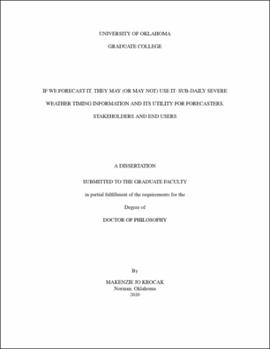| dc.description.abstract | Severe weather causes significant damage and disruption to daily lives, particularly in the eastern half of the United States. While warning creation and communication has been studied extensively, much less work has been devoted to understanding weather information effectiveness on sub-daily scales that are longer than the warning scale. This work focuses on understanding if and how scientists can provide timing information on the convective outlook scale (4-24 hours from the event), and whether that information would be useful to stakeholders and the general public. A mixed-method approach was used, including interviews, surveys, and focus groups with forecasters, emergency managers, and the US population.
Results from the initial feasibility study indicate that a majority of daily severe weather reports at a single location are concentrated within short (around four hours) pe- riods of the convective day. This result is consistent across the US, indicating that timing information could be included within the convective outlook without a drastic change in the product definitions. However, initial testing with forecasters showed that forecasting these shorter periods of time was sufficiently challenging and would need in-depth training and improved verification and calibration methods. Although these challenges did exist, forecasters still noted the value they see in this type of product. Emergency managers also found timing information to be extremely valuable to their decision-making process. They note that the timing of severe weather events impacts when, how, and where they stage resources and dictates what different entities (like schools, workplaces, and municipal ser- vices) do to prepare. Finally, respondents to a national survey of US residents generally reported that they would monitor the weather and make preparations if they were given knowledge of specific timing of severe weather for their area. Many of these respondents also said they would shelter hours before the storms were forecasted to arrive, indicating that future work needs to be done to minimize anchoring effects that are likely occurring during these hypothetical severe weather scenarios.
Ultimately, this work is an attempt to involve researchers, practitioners, and end users in the process of developing new forecast information. The co-production of scientific knowledge and a formal development, testing, refinement, and implementation process will become more important as NOAA implements a more continuous flow of weather information. Such changes must ultimately be vetted with the people and organizations that rely on the weather information we provide. To produce the most useful and effective information, scientists, funding agencies, and policy makers must be flexible enough to allow researchers to see the testing and refinements of scientific knowledge as an asset to the process, not an obligation. | en_US |
